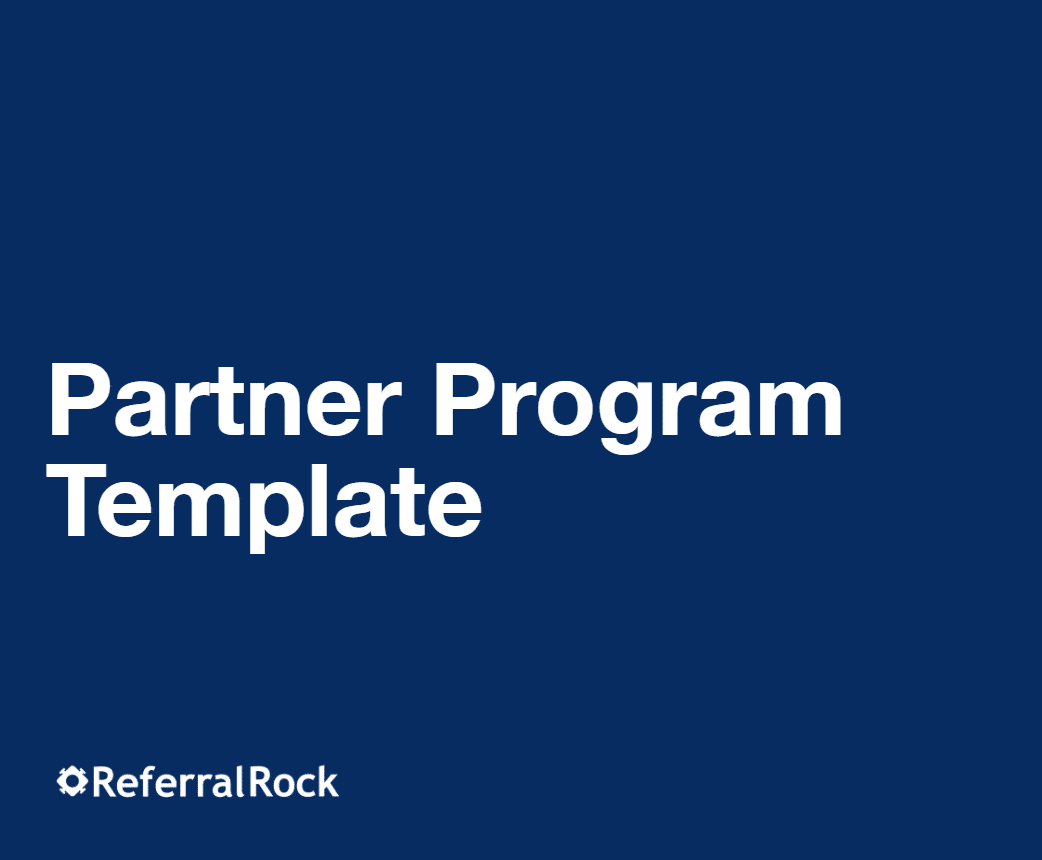Effective long-term and win-win partner relationships are one of the essential keys to a sustainable business model. But to get the best results out of your partnership, and maintain accountability, it’s important to formulate an official structure and lay down some ground rules. And that’s where a partner program template comes in.
In this article, we’ll cover everything you need to know about partner program templates and how to create your own. We will also share a super user-friendly, readymade, editable partner program template you can use as is or customize to make it your own.
What is a partner program template?
Templates are readymade sample documents or frameworks that give you a starting point to work with. They usually have some form of skeletal structure with some information filled in. You can then use the template as a baseline to develop more information or further refine your structure to map out an actual plan.
A partner program template functions the same way. It’s a skeletal structure or framework you can use to lay out all aspects of your channel partner program in a way that’s visible and actionable, and solidify your partner marketing strategy.
You’ll include an outline of your goals, a list of the rewards you want to share with your partners, how the program will operate, and more.
It’s not necessary to have your entire partner program template set up and ready to run from the get-go. It’s more common to start with a basic plan that isn’t entirely finished, and then fill out the rest as you establish the partnership with a specific business or individual.
Templates are living documents. It’s normal if some sections are well-fleshed out, but you don’t have enough information to work with in certain other sections. Think of your partnership program template as a roadmap and not the final destination.
Why do you need a partner program template?
A partner plan template helps you organize all aspects of your partner relationships from start to finish. But over and beyond helping you plan and determine action steps, and set up milestones, a partner plan template can help:
Ensure you don’t overlook any critical aspects of planning and managing the partnership. You don’t want to miss out on any strategic planning steps along the way.
Set expectations for the partnership. It helps determine your roles and how the partners will work individually as well as in tandem.
Set parameters for measuring the partnership’s success once it’s live. When you start fleshing out your program template, you’ll have a better sense of the metrics or KPIs (Key Performance Indicators) you want to record to identify how well you’re doing.
What to include in a partner program template?
Actively build your partner program template before you start sourcing partners. We recommend that you include 12 sections in your template: six for before you shortlist potential partners and six for after you shortlist potential partners. Our readymade downloadable template covers all the necessary sections (we’ll guide you through filling in these sections below).
Download our free partner program template by clicking or tapping on the image below.
We recommend that you include 12 sections in your template: six for before you shortlist potential partners and six for after you shortlist potential partners.
1. Goals
When businesses decide to tie up with partners, it’s often to achieve goals that they wouldn’t be able to achieve on their own. Partnerships help each partner expand their potential and achieve new heights.
The goals section, like the name suggests, is about identifying the specific goals you want to achieve through creating your partnership ecosystem.
Here are some of the most commonly cited goals relevant to any type of business:
- Increase revenue (by how much and by when)
- Increase your customer base (the ballpark figure and by when)
- Break into new markets or verticals (specify the channels)
- Open up new distribution and sales channels:
- Do you plan to do this through retailers or wholesalers?
- Or do you want partners to focus on marketing/advertising the products to new audiences without directly selling the products?
2. How to measure ROI of all partnerships
This next section is about the detailed metrics you will track to measure the success of your partner program. While you’re listing your metrics out, it’s a good idea to follow the SMART formula. They should be specific, measurable, attainable, relevant, and time-bound.
Example ways to measure ROI include:
- Generate a minimum of X amount of partner-driven revenue in a given month, quarter, or year.
- Generate a minimum of X amount of revenue within a new vertical in a given month, quarter, or year.
- Acquire at least X new customers through partnerships within a given month, quarter, or year.
- Acquire at least X new customers in a given geographical region in a given month, quarter, or year.
- Grow your customer base by X% through partnerships in a given month, quarter, or year.
- Increase (monthly, quarterly, yearly) purchases from a specific demographic or channel by X%.
3. Partnership type(s)
The next section is about deciding partnership types. At this point, you’re determining the kind of partnerships that would be beneficial for your business based on your goals and the metrics you want to achieve. Use the following list of partnership types for reference and to help you decide your options:
Retailers, who will sell your products in their physical or online storefronts.
Wholesalers (resellers), who will purchase large quantities of your product all at once and then resell them.
Distributors, who will purchase smaller quantities of your product that will eventually get into retailers’ hands.
Agents or brokers, who will set up relationships between your company and other companies.
Affiliates, who will advertise your products to their online audience and bring traffic and leads right to your website. They won’t be selling your products directly. Your partnership program can function just as effectively and similar to an affiliate program, in this case.
Referral partners, who are trained to share your business with people and companies they already have an existing relationship with.
Other hand-picked advocates, such as brand ambassadors (who love your brand, authentically share how they use your products, and share a link to your website).
4. Finding partners
The “finding partners” section is about head-hunting potential candidates and shortlisting the best. Use the following questionnaire to guide your sourcing and finalizing of partners:
- Where do you plan to find partners who can help you meet your goals? They should have a relevant audience and should ideally fit the type of channel partnerships you’ve selected.
- How much of a reach do you want partners to have? Do you want to look at reach from a local, regional, national, or global perspective?
- What’s the minimum audience size your partners should have? Is there a maximum?
- What level of experience do you want partners to have? Would you consider partners that are startups but check all the right boxes, for example?
- Do you have any specific partners in mind? If not, you’ll need to do further research online to hunt down potential partners.
- Do you want partners who are already familiar with your products/services? Or should they at least have a background or established understanding of your niche (SaaS or others, as the case may be)?
- How do you want partners to distribute your products?
- How many partners will you need, based on your goals and budget?
- If you want to partner with companies, who are the key decision makers or stakeholders who will be your primary points of contact for the partnership?
Once you’ve made a shortlist of potential partners, evaluate their suitability with these questions:
- What unique advantages would a given potential partner bring you?
- What can you offer a potential partner that they can’t achieve on their own?
- What are their values, and are they consistent with your brand mission and values?
- Are there any deal breakers – traits you don’t want in a partner?
5. Incentives you’ll offer
Next, you’re going to work on the specific incentives, otherwise known as the rewards you’re going to be offering to your partners or partner managers.
What monetary incentives will you offer to encourage partners to sign on? Some examples to consider include:
- Flat-fee commissions on each sale
- Percentage commissions on each sale
- Wholesale discounts
- Non-cash incentives, such as a trip, gift card, or valuable tech item, that get sent directly to the salespeople after they sell a certain number of your products/services (known as a sales performance incentive fund, or SPIF)
- Cash that goes to the partner’s business as a whole, helping the business accomplish sales and marketing goals (known as a market development fund, or MDF)
- A co-op fund
Next, how will you make sure these incentives grow in value the more sales a partner makes? Will you offer other secondary incentives as well, like spotlights on your website, meals at high-quality restaurants, or exclusive events just for partners?
6. Tools and software
It’s not recommended to manage a partner program manually using basic tools like spreadsheets. Given that your partner program is going to function like a self-contained unit with branches to key stakeholders, it’s ideal to have Partner Relationship Management or PRM software in place.
Aside from giving you a single 360-degree view into your operations, PRM software also helps you streamline the tracking and management of your partner program.
Here are a few specific points to consider when you’re narrowing down on software for your business:
- Is it able to manage the type(s) of partners you want to utilize?
- Does it integrate well with your existing software and processes?
- How does it help you onboard and communicate with partners, including through a partner portal?
- How does it help you boost partner engagement?
- What partnership reward structures is it capable of managing?
- What metrics does it track so that you can determine your program’s success?
7. Reaching out to potential partners
As you reach out to partners you’d like to work with, determine the following:
- What are their goals for a partnership?
- What benefits do they want to get out of the partnership?
- What mutual goals do you have?
- What do you offer each other that you can’t achieve on their own?
- What challenges do you each foresee?
Then, choose the partners that offer the most ideal partnerships, and make things official by having them sign a partner program agreement.
8. Partnership business plan
Next up, you want to develop your partnership business plan. Use these questions to guide the process:
- What are the partner’s core duties and expectations?
- What will you accomplish for the partner?
- What distribution channels will the partners use?
- How will the partners market and sell your products/services to their audience (with what sorts of messages and techniques)?
- How do your and your partner’s offerings (products, services, expertise, relationships with an audience) add value to each other?
- How do leads enter your sales pipeline when they come through a partner?
- Will you be referring leads and sales to your partner as well? How so?
9. The partnership agreement
The partnership agreement is about documenting the terms of engagement in your partnership so both sides are clear on expectations. Draft up your official agreement after you’ve decided to work together but before you confirm your partnership. You and your partner must sign the agreement before the partnership proceeds.
The exact terms of engagement can vary depending on the partnership type and your specific partner program goals.
Include the following in the agreement:
- What the partner is expected to accomplish
- What you’ll offer to give value to the partner
- Your payment terms (the incentives and what must be done to earn them)
- Rules for how your partner can and can’t promote your brand
- Confidentiality section: anything your partner must keep confidential
- Any other terms and sections you wish to include
10. How to measure ROI of individual partnerships
Next, you want to record how you will measure the success of your partnerships through clear and specific ROI goals. Determine what SMART goals you’ll set to measure the success of an individual partnership, and how you’ll enable partners to track the progress towards these goals.
11. Onboarding and training
Onboarding and training are just as relevant as the other items on your partner program template. Providing a great onboarding experience signals your investment in the success of the partnership and kicks things off on a positive note.
Determine how you’ll onboard and train your partners, as well as which channels you’ll use for this purpose:
- What marketing materials (tools, assets, and resources) will you provide them, and how?
- Will you have a partner portal?
- What are the standards for how your brand should be represented?
- What key product information should a partner cover during the sales process?
- How will you customize the training for each partner?
- How can the individual partner pitch the product to meet the needs of your shared audience?
12. Partner communication
Last but not least, nail down your partner program communication processes, the channels you will use, and how they will function.
Determine how you’ll communicate with and update partners as needed, and how you’ll supply them with everything they need for the enablement of successful channel sales. Also, establish your process for checking progress towards your goals, including whether you’ll implement partnership performance reviews, and how you’ll proceed if the partnership isn’t performing how you expected.
Conclusion
Creating your own partner program template based on the guidelines we’ve provided can help you remove much of the guesswork of partner program management. Continue to check back in and reflect on ongoing learnings, so you can continue to refine the template for more value as your business grows.





